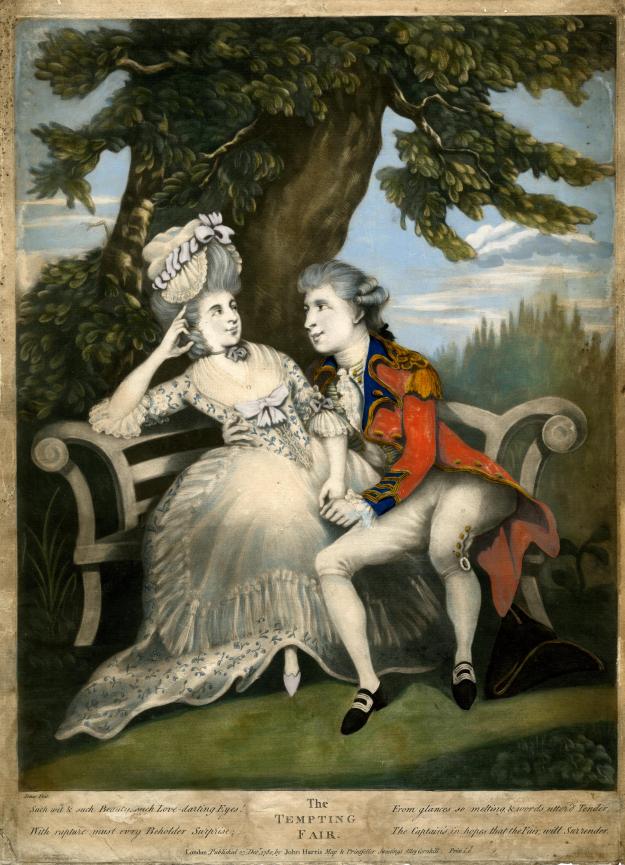
The Tempting Fair
print made by John Jones and published by John Harris 1780 Hand-coloured mezzotint with some etching All images © The Trustees of the British Museum
As Valentine’s Day approaches, I was delighted to happen across these satirical prints depicting romantic dramas. Produced by various artists and published in London, mostly in the late 18th century, they are now part of the British Museum’s collection. All set in parks and gardens, this pleasing combination of love and horticulture seems singularly appropriate to the season.
With the cultural constraints imposed on personal interactions between the sexes in this period, it’s not difficult to see why lovers might have preferred to conduct their encounters out of doors, away from the inquisitive eyes and ears of the household. The garden, with its avenues and groves, was a perfect place to escape observation; to stroll, or sit together for a while on a conveniently placed bench, and enjoy some privacy.
A range of romantic motivations is revealed by the characters in these prints. Some innocent individuals long for love, whilst others appear ambivalent about the nature of the attentions they are receiving. The English taste for innuendo is evident in the scenes of illicit meetings and predatory searches for a partner. The absurdity of lovers’ behaviour to the eyes of outsiders is a constant theme, either witnessed by onlookers, or by the viewer.
For those of us interested in gardens of the past, these prints reveal a multitude of garden features – a series of beautiful painted wooden benches in various styles are my particular favourites. Details of the lovers’ clothes are also fascinating. But now, let us go to the garden, take a walk amongst the flowers and learn love’s lessons:
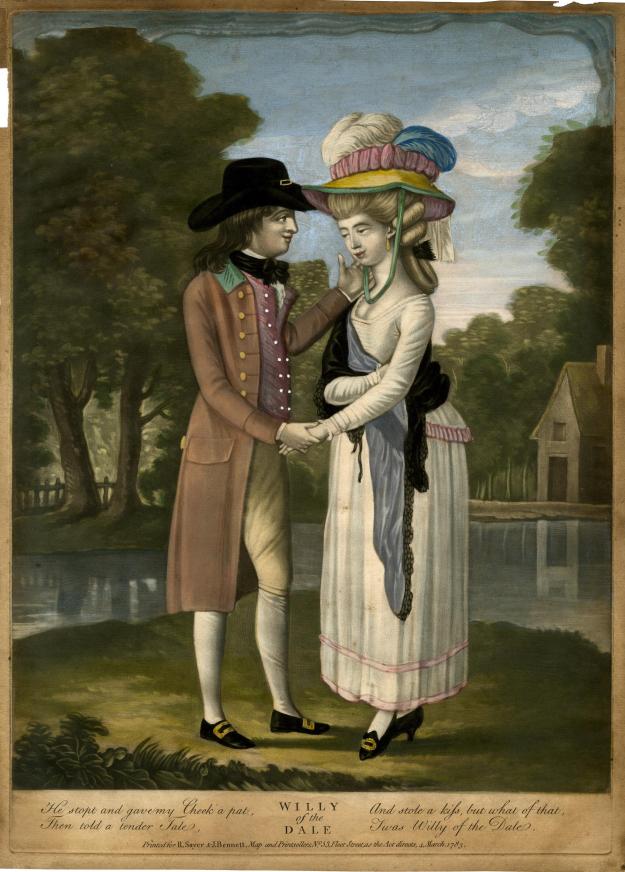
Willy of the Dale published by Sayer and Bennett 1783 Hand-coloured mezzotint
There’s a suggestion that Willy of the Dale might not be entirely sincere when he pats the cheek of his female companion and steals a kiss as they stand by the water’s edge – and perhaps Damon the gardener’s gift of a posy of flowers is not quite the innocent transaction it appears; he seems to expect something in return from Phillis, his young companion.
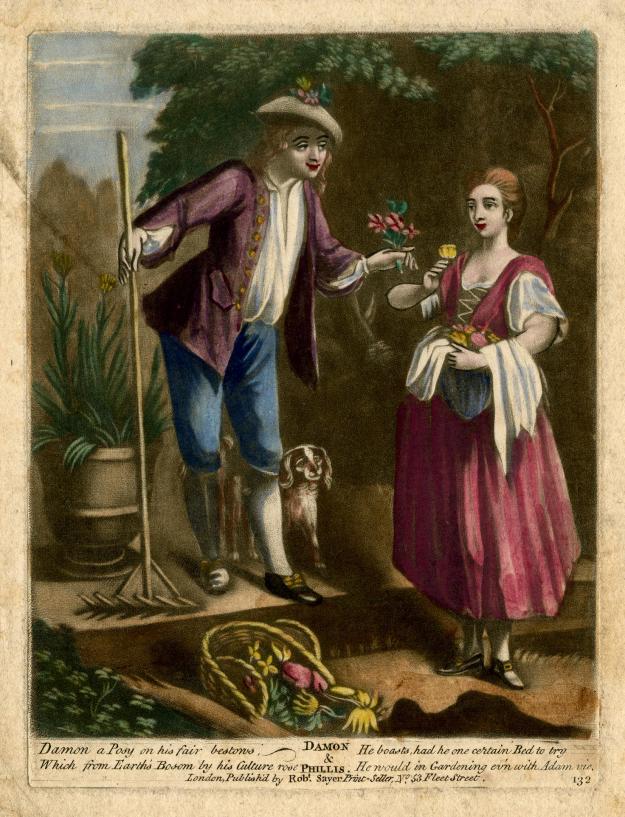
Damon and Phillis published by Robert Sayer 1760s – 1792 circa Hand-coloured mezzotint
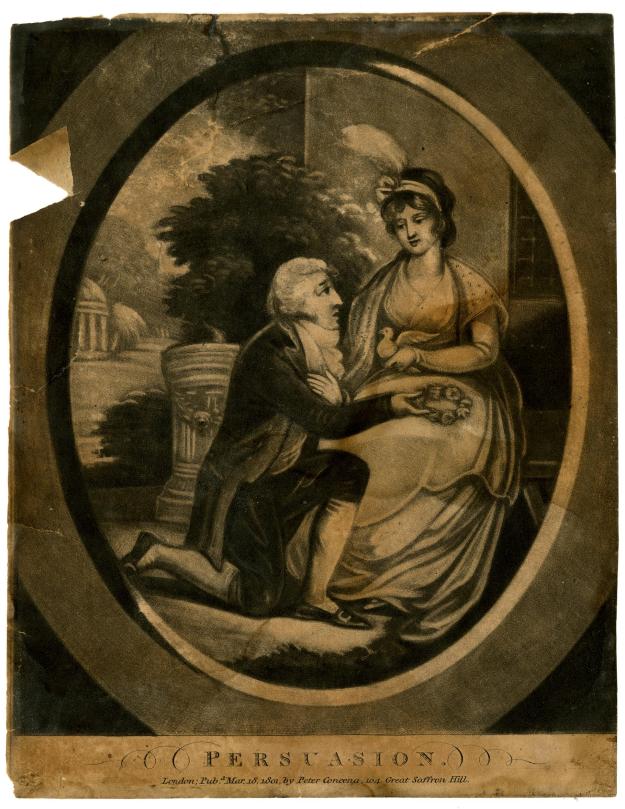
Persuasion published by Peter Concena 1801 Mezzotint with some etching
The seated woman in Persuasion seems ambivalent about the garland of flowers she is receiving from her kneeling admirer.
However, in The Thorn, the young man’s proposal in the garden, with its winding pathway and trellis shelters, is accepted.
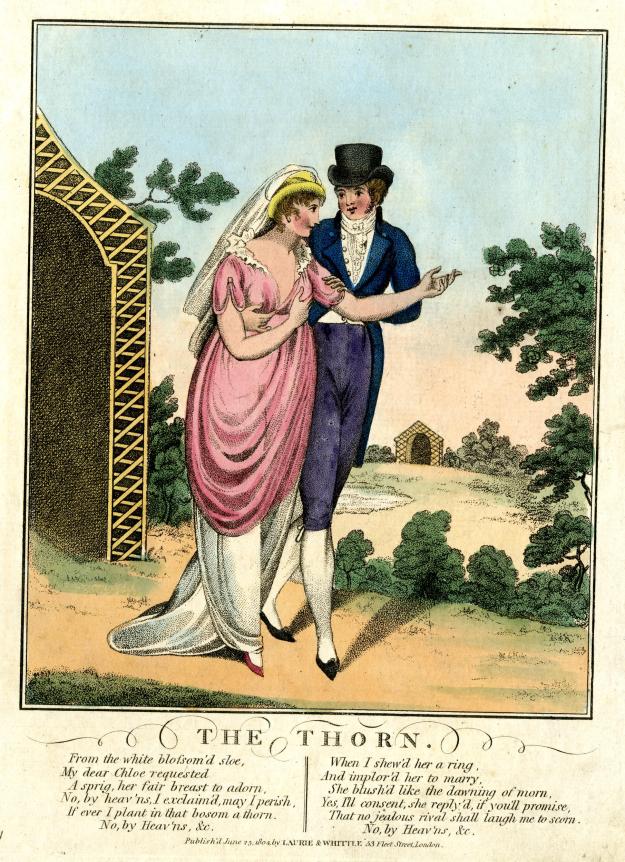
The Thorn published by Laurie and Whittle 1804 Hand-coloured stipple and etching
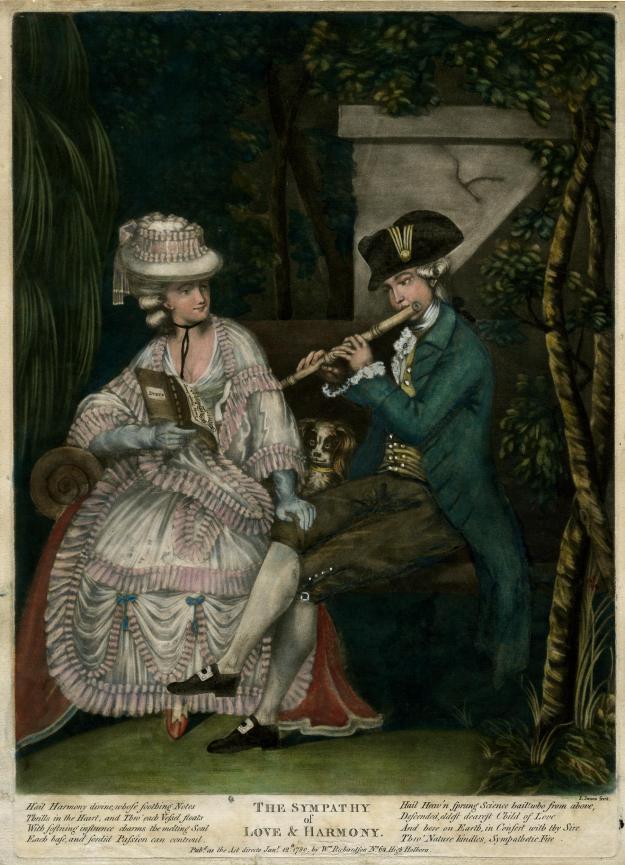
The Sympathy of Love and Harmony print made by John Jones and published by William Richardson 1780 Hand-coloured mezzotint with some etching
Here, music is used as a metaphor for harmony in love. The man plays the flute as his partner holds up the book of music for him to read, whilst resting her hand on his knee. The black and white print appears to be a later version of the theme.
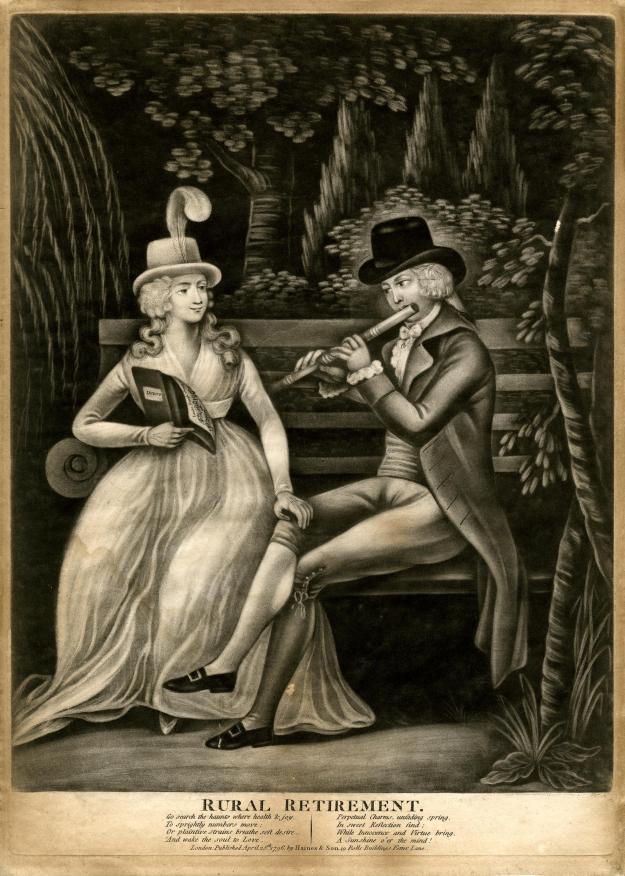
Rural Retirement published by Haines and Son 1796 Mezzotint with some etching
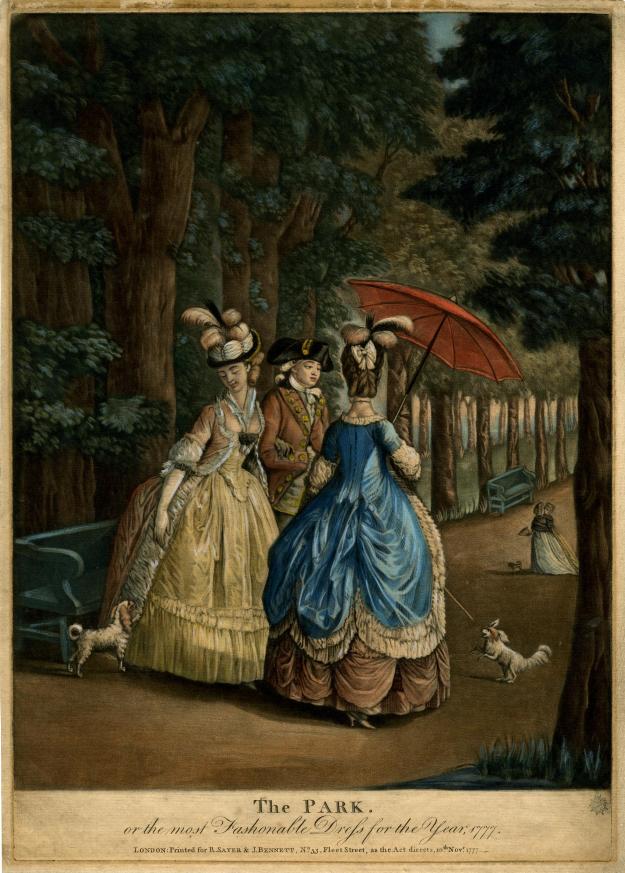
The Park. or the most Fashionable Dress for the Year, published by Sayer and Bennett 1777 Hand-coloured mezzotint with some etching
The Park, or the most fashionable dress for the year 1777 shows a young woman dressed in blue silk with a red parasol, with a smart young couple and their dogs walking along a tree lined avenue, populated with regularly spaced benches for those who need to rest or converse. Here, the park is a place to dress up and be seen, and perhaps make new introductions.
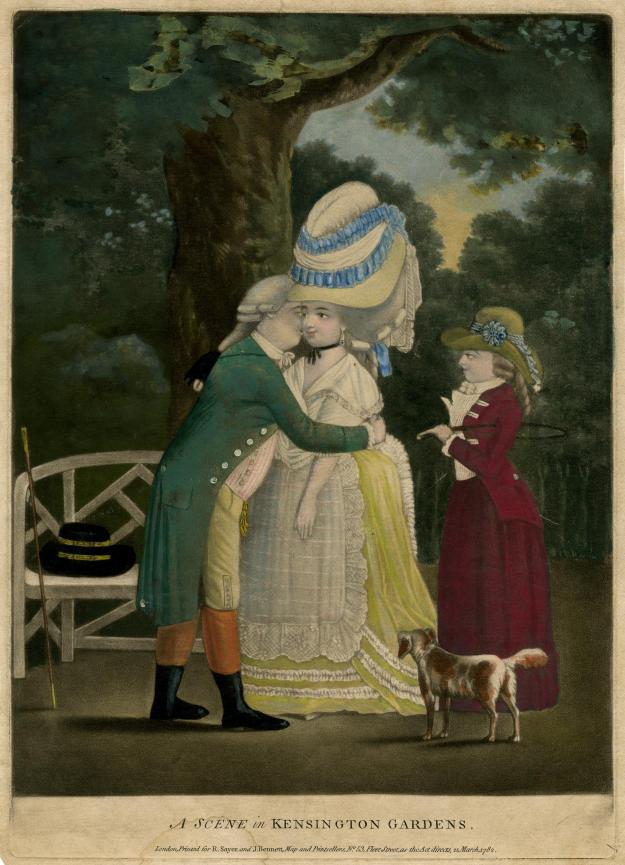
A Scene in Kensington Gardens published by Sayer and Bennett 1782 Hand-coloured mezzotint
A Scene in Kensington Gardens features a somewhat awkward meeting between two lovers, as a woman in riding dress, and a dog, look on.
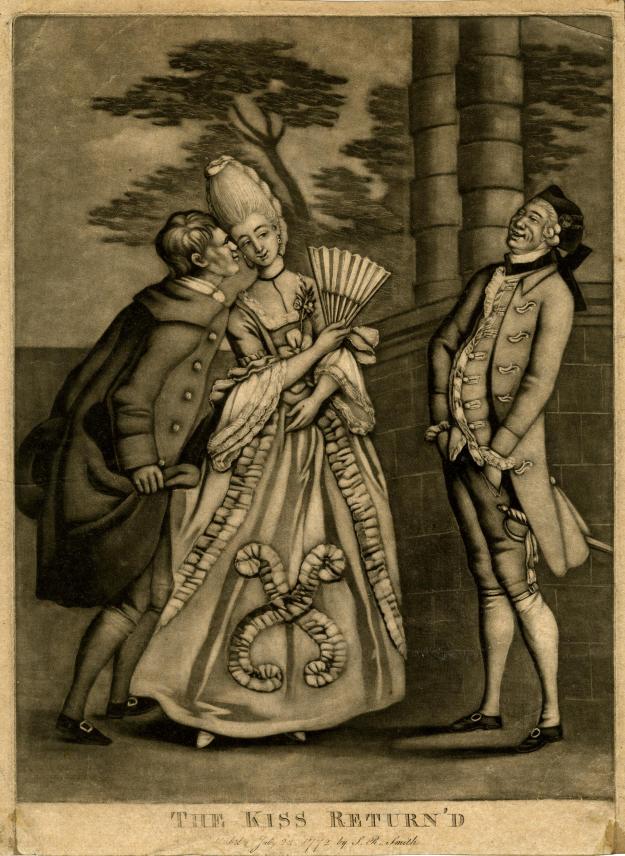
The Kiss Return’d published by John Raphael Smith 1772 Mezzotint
‘A young man in simple dress, clutching the edge of his coat in one hand and his hat in the other, kissing a fashionably-dressed lay who holds a fan, watched by a gentleman who stands on the right, hands in his pockets, laughing; in a garden with a wall and columns behind.’ British Museum
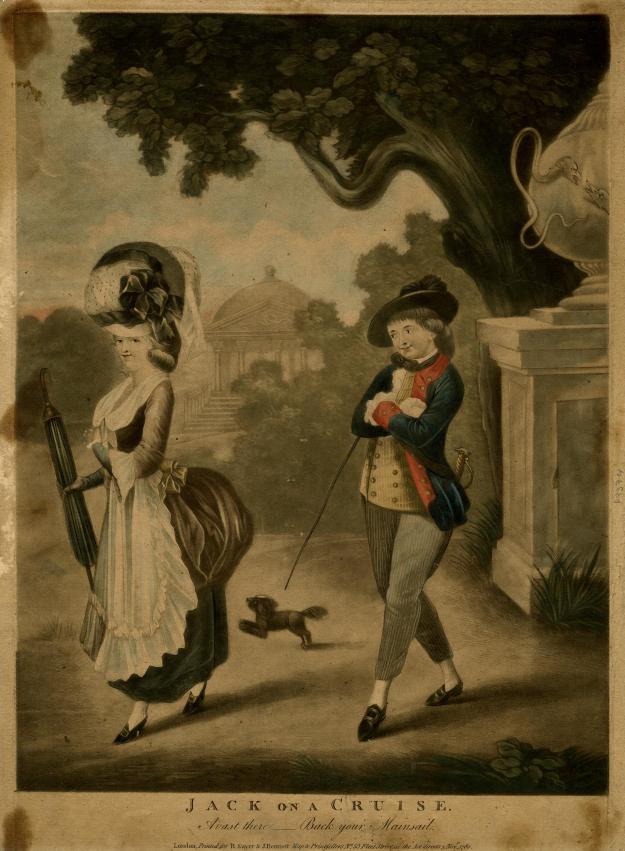
Jack on a Cruise published by Sayer and Bennett 1780 Hand-coloured mezzotint with some etching
A certain urgency in the search to meet a partner is clear in Jack on a Cruise where a young woman pursued by a sailor gives a coy, but knowing, look to the viewer. The British Museum commentary notes the grand nature of this garden setting – ‘an urn with serpents sits on a high rectangular pedestal under a large tree, and in the distance is a pavilion in the form of a temple with a dome, pediment, and Corinthian columns.’
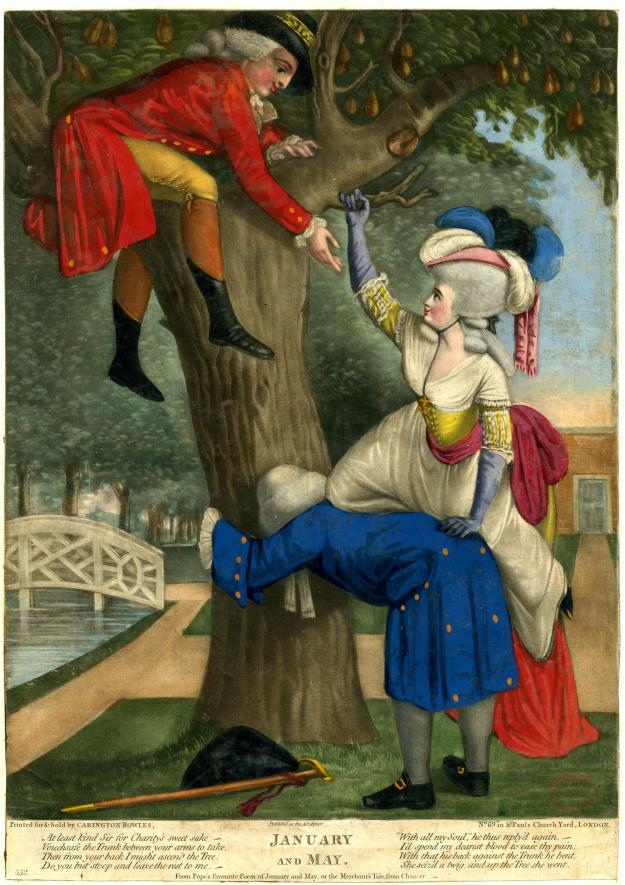
January and May published by Carrington Bowles 1785 Hand-coloured mezzotint
‘Beneath the title is engraved, ‘From Pope’s favourite Poem of January and May, or the Merchant’s Tale, from Chaucer’. A garden scene. A young woman (right) kneels on the back of her blind old husband, who stoops down, clasping the trunk of a pear-tree to support her that she may reach her lover who sits in its branches leaning towards her. The old man is dressed in an old-fashioned manner, with wide cuffs; the other two are fashionably dressed: she wears a feathered hat and long elbow-gloves; the anchor of Hope is suspended from her neck on a ribbon. He wears boots with deep tops, and a round hat. In the background (right) is a piece of water crossed by a wooden bridge with Chinese rails. Beneath the design are engraved eight lines from Pope, beginning, ‘At least kind Sir, for Charity’s sweet sake / Vouchsafe the Trunk between your arms to take,’. (She is pregnant, and has deceitfully asked her doting husband to help her to reach a pear for which she craves.)’ British Museum
In London, close to King’s Cross, a tea house with public gardens called Bagnigge Wells became notorious towards the end of the 18th century as a centre for prostitution and both these prints show women dressed elaborately to attract customers.
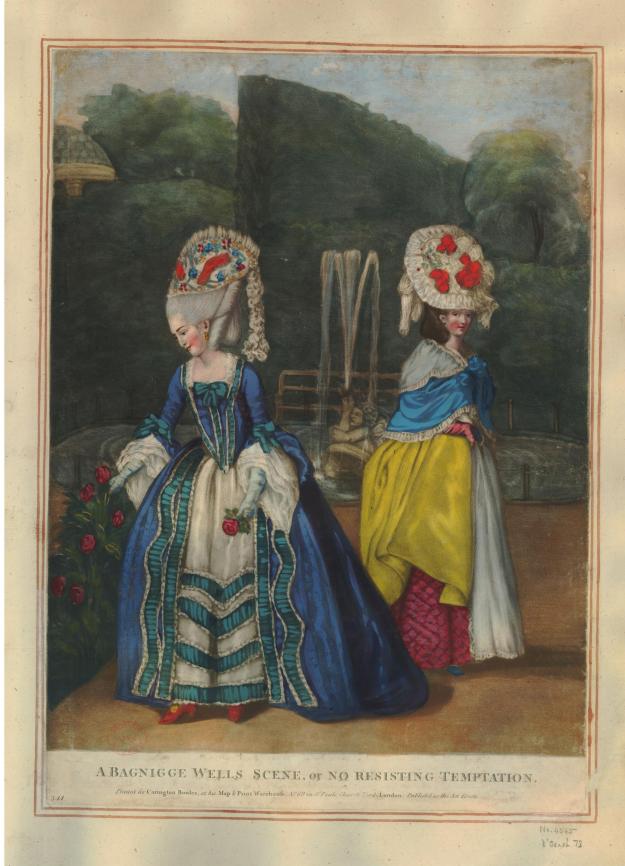
A Bagnigge Wells scene, or No Resisting Temptation print made by John Raphael Smith published by Carrington Bowles 1780 Hand-coloured mezzotint
‘Two finely dressed prostitutes in the grounds of the pleasure garden with a fountain playing in the background.’ British Museum
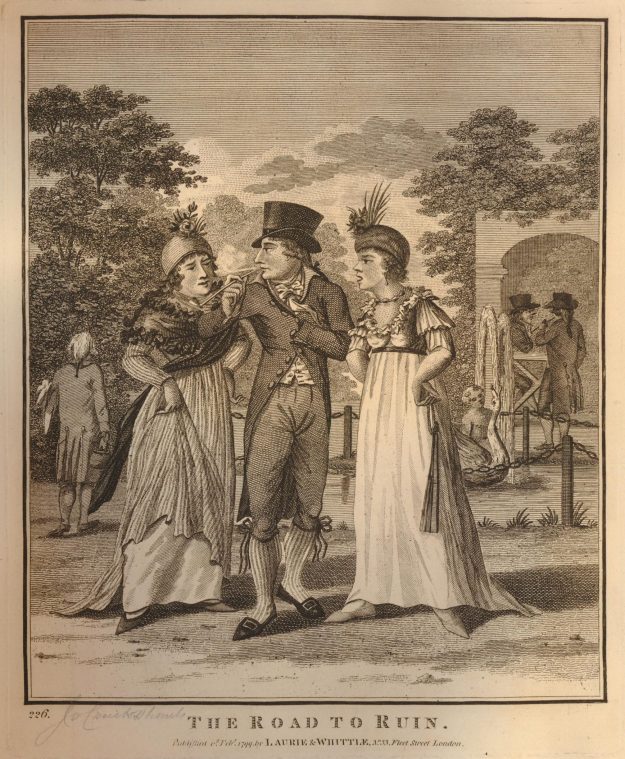
The Road to Ruin published by Laurie and Whittle 1799
‘A young man, probably an apprentice, in fashionable but ill-fitting dress, stands smoking between two prostitutes, who berate him, arms akimbo. In the background is the fountain, water spouting from a swan.’ British Museum
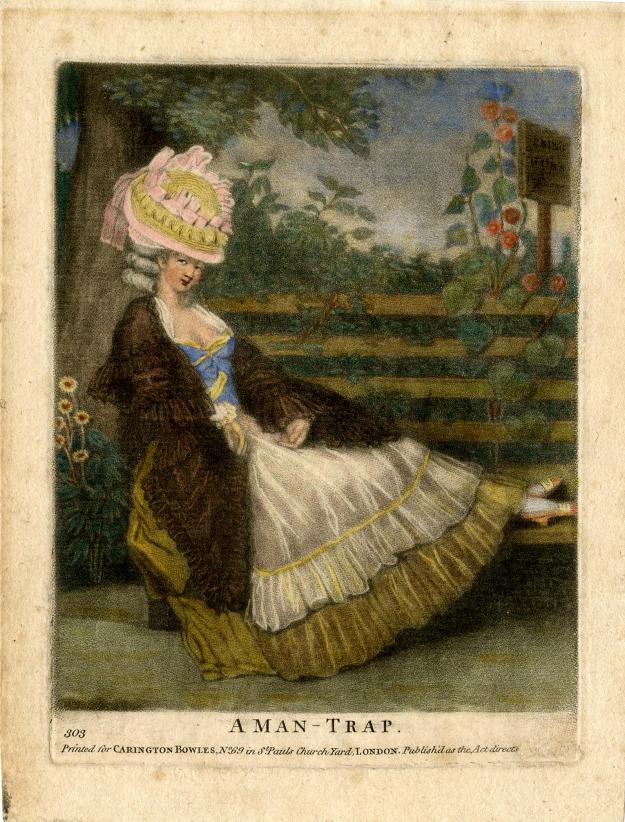
A Man-Trap published by Carrington Bowles 1766 – 1789 circa Hand-coloured mezzotint with some etching
The theme of the seductress is continued in A Man Trap, where a woman with a magnificent hat and apricot coloured shoes reclines on a garden seat. Looking provocatively at the viewer, the sign to her right reads ‘Spring Guns’, indicating the young men she seeks to attract. The association of gardens with nefarious activity continued into the 19th century, with Vauxhall Gardens eventually closing its gates, in part due to its poor moral reputation.
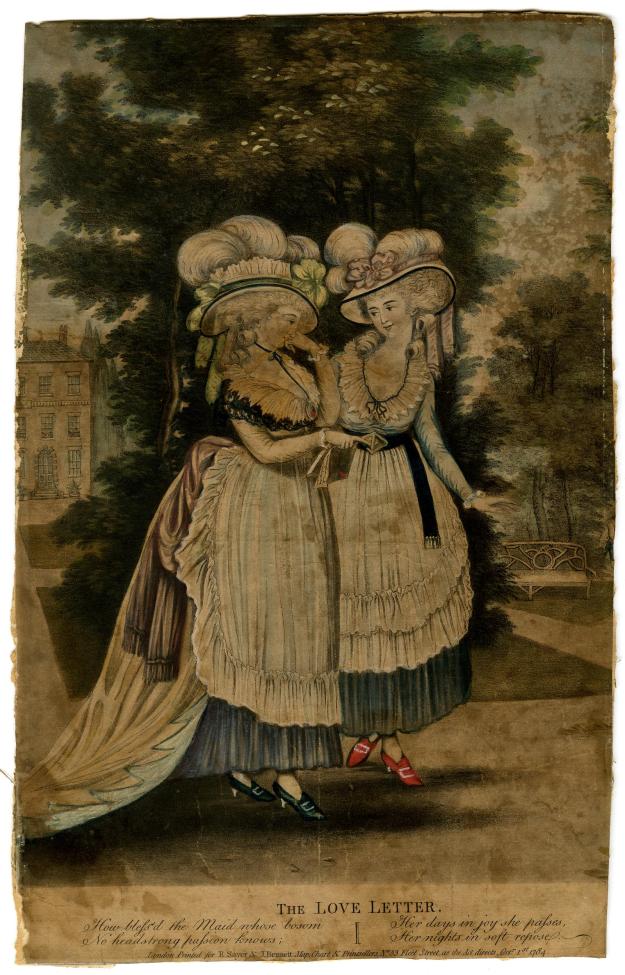
The Love Letter published by Sayer and Bennett 1784 Hand-coloured mezzotint with etching
‘Two fashionably-dressed young women walking in a garden, the one on the left holding a love letter; a large house in the background to left and a bench in the distance to right.’ British Museum
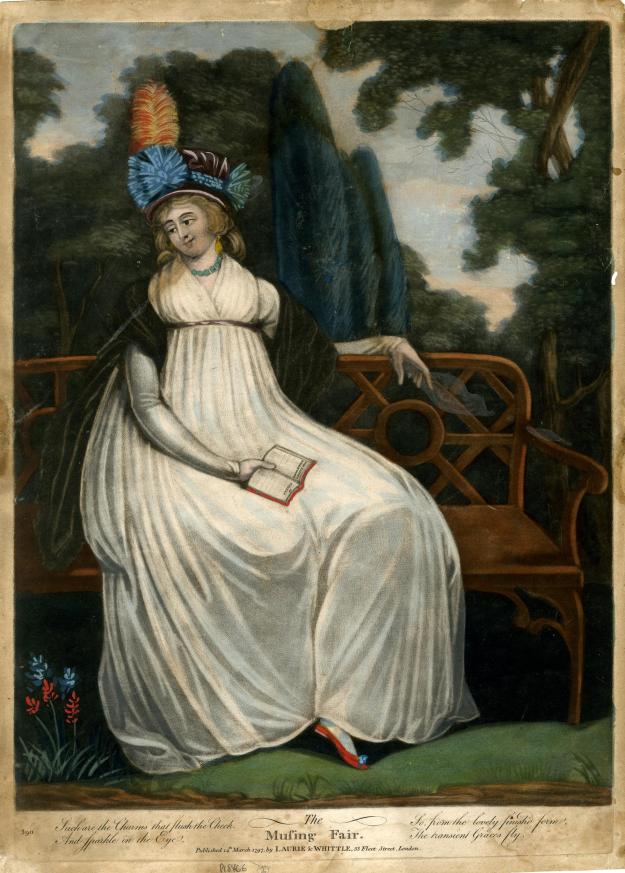
The Musing Fair published by Laurie and Whittle 1797 Hand-coloured mezzotint with some etching
The young woman in The Musing Fair is reading a book called ‘The Farmer of Englewood Forest’ – and perhaps hoping she might meet a similar kind of man one day?
Has the pensive looking woman in Reflections in a Flower Garden experienced disappointment in love?
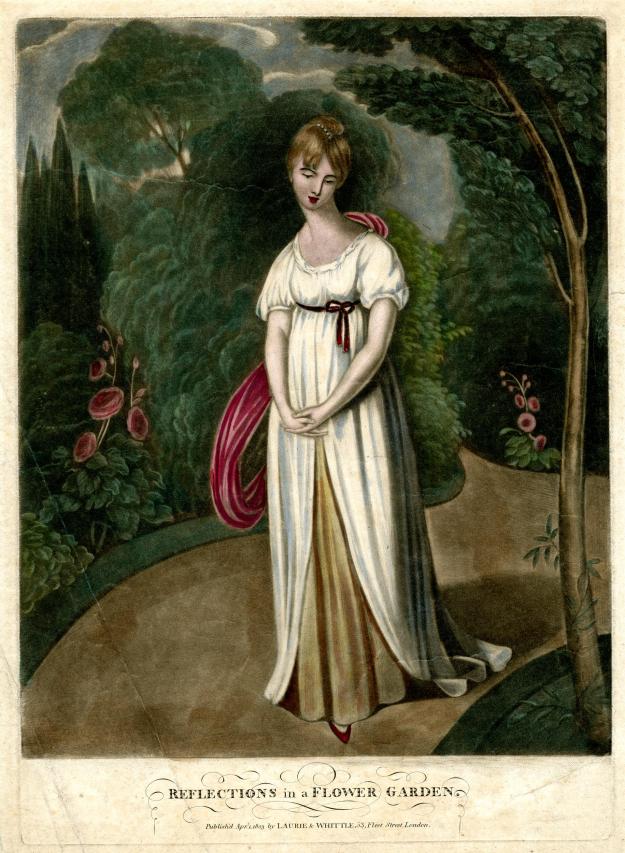
Reflections in a Flower Garden published by Laurie and Whittle 1803 Hand-coloured mezzotint
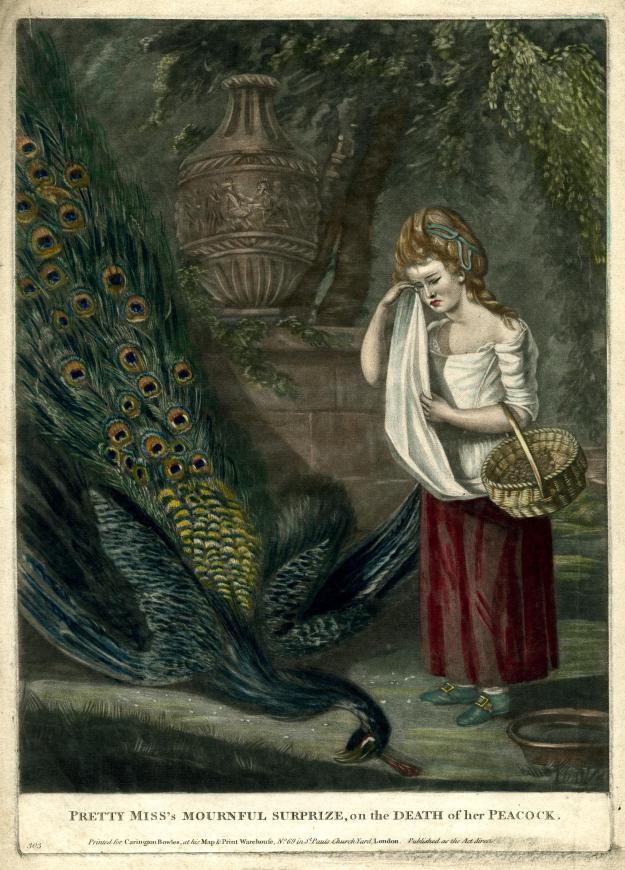
Pretty Miss’s Mournful Surprize, on the Death of her Peacock published by Carrington Bowles 1766 – 1784 circa Hand-coloured mezzotint with some etching
‘A girl standing weeping in a garden holding her apron to her eyes, seeing a peacock lying dead, fallen from a wall on the left.’ British Museum
Peacocks, originally from India, were popular as living adornments to the gardens of country houses in the 18th century and it would seem likely that some owners became personally attached to their birds, as well as appreciating their decorative qualities. This strangely out-sized bird appears to have met its death by falling off a wall (according to the British Museum commentary) – perhaps its wings were clipped so it couldn’t fly away from the garden?
Hoping your Valentine’s Day is a happy one.
Further reading:
These prints are from The British Museum’s vast online collection here
More about Bagnigge Wells from A London Inheritance here
